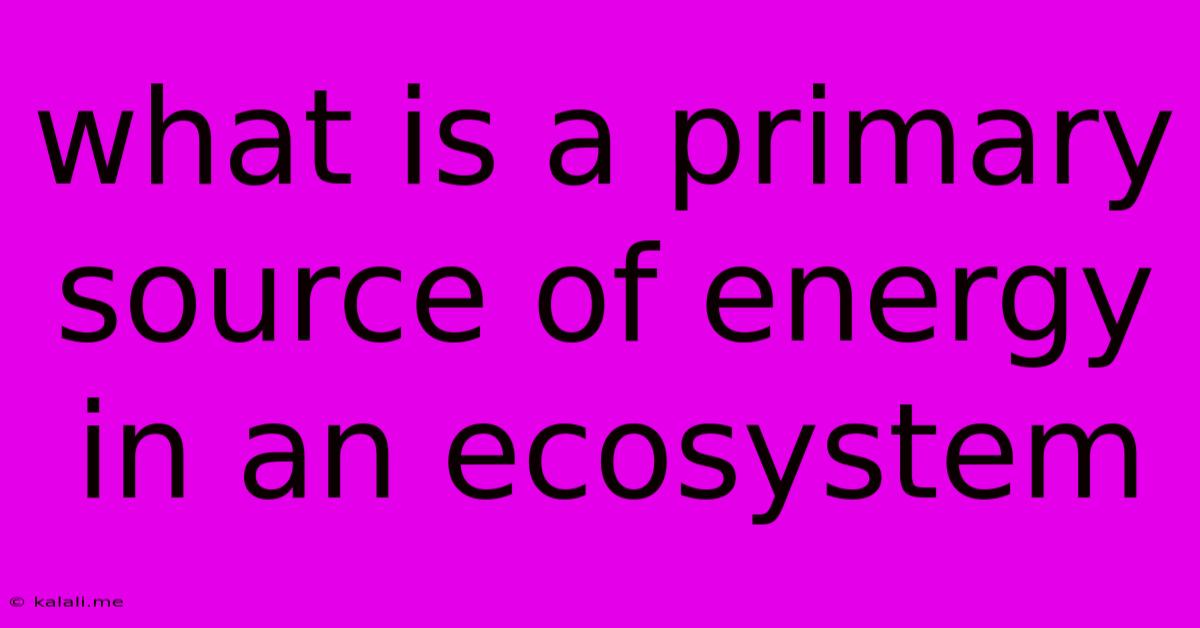What Is A Primary Source Of Energy In An Ecosystem
Kalali
Jun 14, 2025 · 3 min read

Table of Contents
What is the Primary Source of Energy in an Ecosystem?
The sun is the ultimate primary source of energy for almost all ecosystems on Earth. This might seem obvious, but understanding why and how this is true is crucial to grasping the fundamental workings of any ecological system. This article delves into the role of the sun, exploring its energy conversion within ecosystems and addressing exceptions to this rule.
What Makes the Sun the Primary Energy Source?
Sunlight fuels nearly all life on Earth indirectly or directly. Photosynthetic organisms, like plants and algae, are the primary producers. They use a process called photosynthesis to convert light energy into chemical energy in the form of sugars (glucose). This process is the foundation of most food webs. Think of it as the initial energy deposit into the ecosystem's "bank account."
The Flow of Energy: From Sun to Apex Predator
The energy captured by producers is then transferred through the ecosystem via a food chain or food web. Here's a simplified look at this energy flow:
- Producers (Autotrophs): Plants, algae, and some bacteria capture sunlight and convert it into chemical energy through photosynthesis. They form the base of the food web.
- Primary Consumers (Herbivores): Animals that eat plants (e.g., rabbits, deer, grasshoppers) obtain energy by consuming producers.
- Secondary Consumers (Carnivores): Animals that eat herbivores (e.g., foxes, wolves, snakes) obtain energy by consuming primary consumers.
- Tertiary Consumers (Top Carnivores): Animals that eat other carnivores (e.g., lions, sharks, eagles) sit at the top of the food chain.
- Decomposers (Detritivores): Fungi and bacteria break down dead organic matter, returning essential nutrients to the soil and completing the cycle.
Energy Transfer and Efficiency:
It's important to note that energy transfer between trophic levels (feeding levels) isn't 100% efficient. Only about 10% of the energy from one level is transferred to the next. The rest is lost as heat through metabolic processes. This explains why food chains typically have only a few trophic levels.
Exceptions to the Rule: Chemosynthesis
While the sun is the primary energy source for most ecosystems, there are exceptions. Deep-sea hydrothermal vent ecosystems rely on chemosynthesis. Here, specialized bacteria use the chemical energy from hydrothermal vents (releasing chemicals like hydrogen sulfide) to produce organic matter. These bacteria form the base of the food web in these unique environments. This demonstrates that while sunlight is dominant, other energy sources can support life in specific circumstances.
The Importance of Understanding Primary Energy Sources:
Understanding the primary source of energy in an ecosystem is crucial for several reasons:
- Conservation efforts: Knowing how energy flows helps us understand the impact of habitat loss, pollution, and climate change on ecosystems.
- Sustainable resource management: It informs effective strategies for managing fisheries, forests, and other natural resources.
- Ecological modelling: Accurate models of ecosystem dynamics rely on a clear understanding of energy flow.
In conclusion, while chemosynthesis presents unique exceptions, the sun remains the dominant and most significant primary source of energy for the vast majority of Earth's ecosystems. Its role in driving photosynthesis and fueling food webs is fundamental to the functioning of life as we know it. Understanding this fundamental principle is vital for ecological studies and conservation efforts.
Latest Posts
Latest Posts
-
What Is The Percentage Of 300
Jun 14, 2025
-
Which Of The Following Is Radially Symmetrical
Jun 14, 2025
-
Which Of The Following Is An Example Of A Decomposer
Jun 14, 2025
-
Second Most Abundant Element On Earth
Jun 14, 2025
-
In Which Stage Of Meiosis Crossing Over Takes Place
Jun 14, 2025
Related Post
Thank you for visiting our website which covers about What Is A Primary Source Of Energy In An Ecosystem . We hope the information provided has been useful to you. Feel free to contact us if you have any questions or need further assistance. See you next time and don't miss to bookmark.